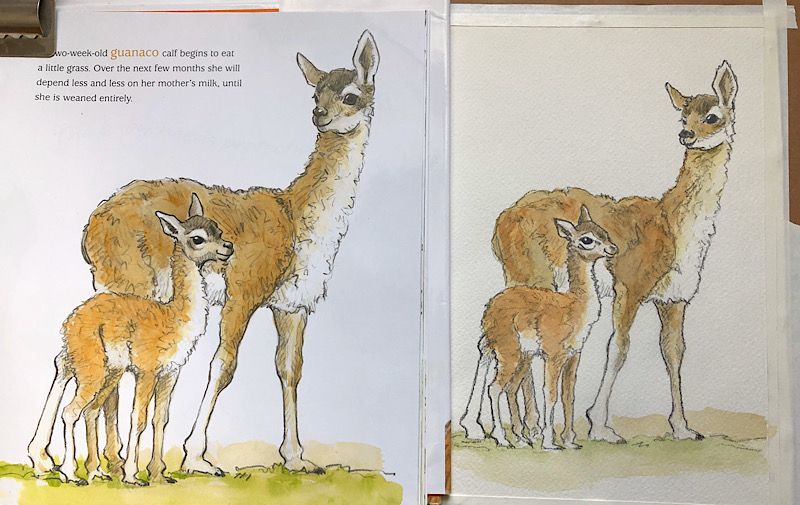Watercolor illustration artists
-
@Whitney-Simms said in Watercolor illustration artists:
Anita Jeram
I really do like her style. I think I'm going to do master studies of some of the people listed in this thread and she is definitely going on that list. Thanks!
-
@burvantill I looked at the Hollie Hobbie's illustrations and realized that even though I knew her name, I had never really looked at her work. I love the old fashioned look of her paintings.
-
@Finn This is a very helpful response because I realized that part of my problem is that I haven't even been sure of how to describe the style I'm trying to emulate which you did really well here -- draftsman, not a lot of pigment, less wet on wet, more transparent and natural colors. I'm also very interested in learning how to create line that blends with the watercolor better and is softer than a black ink line. (Although, I do like the Winnie the Pooh style too.)
-
@demotlj In "the art of holly hobbie" she says that she uses/used colored ink for her line work and detail. But it does not say if she laid it down before or after the watercolor. Is colored ink normally waterproof?
 I too would like a more subtle line.
I too would like a more subtle line. 
-
Hello! Have you seen "the mind of watercolor" last you tube video? He uses colorpencils for the line work and watercolors for the coloring. Nothing like Beatrix Potter but still interesting to watch.
I recently used ink over a watercolor and I was disppointed by the lines : it was not as delicate as when I put them first on paper. And although I use half permanent ink, I am always afraid to have muddy colors if I do it the other way round (first the ink, then applying watercolors). I wish I could show you, if only I knew how to post a picture on the forum from my mobile phone!
Good luck in your search. It is a good thread and I shall follow the comments on that topic!
-
@Julia said in Watercolor illustration artists:
if only I knew how to post a picture on the forum from my mobile phone!


-
@demotlj For the line work that blends in with watercolor, just use watercolor. It's gotten a bit forgotten, but I think historically, in the past, long long in faraway England
 , watercolor was considered to be a drawing medium, not a painting medium in the sense that you used the brush like a pen (which is perhaps why Winsor and Newton's Series 7 are so good
, watercolor was considered to be a drawing medium, not a painting medium in the sense that you used the brush like a pen (which is perhaps why Winsor and Newton's Series 7 are so good  ). It was used for detailed, draftsmanship; to add slight color to fine drawings (see the Dutch landscape painters' prep work), less for loose, painterly, expressive application that is popular nowadays. And they used the watercolor brush to apply hatching and line, instead of washes. It's slower, so few people do it now. Plus you need to know how to draw, to few people do it now. Plus I think in the US people are more familiar with Sargent, Winslow Homer and perhaps Tuner's late work. But look at Germans (I'm from Germany, so I've got other influences) like Dürer's watercolors, look at the Dutch Golden Age watercolors, Pisanello. Look at the hatching work in Giovanna Garzoni's work - it's 17th century tempera - but basically tempera style is exactly what you're looking at I think - transparent, colorful but subtle, linework, draftsmanship. Hope that helps.
). It was used for detailed, draftsmanship; to add slight color to fine drawings (see the Dutch landscape painters' prep work), less for loose, painterly, expressive application that is popular nowadays. And they used the watercolor brush to apply hatching and line, instead of washes. It's slower, so few people do it now. Plus you need to know how to draw, to few people do it now. Plus I think in the US people are more familiar with Sargent, Winslow Homer and perhaps Tuner's late work. But look at Germans (I'm from Germany, so I've got other influences) like Dürer's watercolors, look at the Dutch Golden Age watercolors, Pisanello. Look at the hatching work in Giovanna Garzoni's work - it's 17th century tempera - but basically tempera style is exactly what you're looking at I think - transparent, colorful but subtle, linework, draftsmanship. Hope that helps. 
-
@Finn What great information! Maybe this is why this style appeals to me -- I've always thought I was born in the wrong century

-
@burvantill oh! Thank you!! This is really silly of me! this button escaped my notice!
-
@Julia You’re welcome
 . Same thing happened to me when I first started using the forum.
. Same thing happened to me when I first started using the forum. 
-
@Julia Not silly at all. I, too, didn’t find that button until I had been posting for a while.
-
@TessaW The book “Cozy Days: The Art of Iraville” came today and I love her art. She also describes her process and even says, “I don’t use watercolor the way it is traditionally used,” referring to her more controlled style. It’s a great book. Thanks for the recommendation.
-
@demotlj Yay! Glad it resonated with you.

-
@demotlj She also has a youtube channel that I'm addicted to.
-
I decided to do master copies of some of the illustrators recommended in this thread so I started with one I have admired for some time -- Lita Judge. I scanned and printed the page in monochrome, and then traced it onto watercolor paper using a light table trying to pay very close attention to how she did the contour line as I traced it. (I am mostly interested in her use of line and watercolor and didn't want to spend time figuring out the composition itself which is why I scanned it.) I then painted it, went back over a lot of the contour line, and added all of the interior details and texture with 4B pencil. Here is the result.

I had emailed her once about her process and she said that she does the line art in pencil, paints it, and goes over it again in pencil, and I could see that when I looked closely because some of the pencil is muted by the paint and some is more distinct.
Here's what I learned from this:
-
She rarely had a long solid line even on the contour. The leg bone lines were more continuous but everywhere else, the line was broken and lively. I am waaay too controlled when I ink/pencil my final line.
-
In a similar way, the paint is very uneven. She might have had a light yellow wash under everything but if she did, I don't think she did it as an even wash, and the rust colors are definitely dabbed with wet in wet or dry in wet.
The result is a very "loose yet controlled" look. The drawing does most of the work but the watercolor accentuates the liveliness of the line.
On to the next master study!
-
-
Good idea for a study. I love this type of rendering and think the pencil linework is gorgeous. You did a really good job.